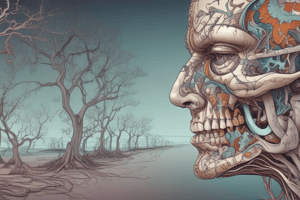Podcast
Questions and Answers
What characterizes a flaccid bladder following an acute spinal cord lesion?
What characterizes a flaccid bladder following an acute spinal cord lesion?
- Regular complete evacuation of bladder
- Urinary retention and inactive bladder (correct)
- Frequent uncontrolled voiding
- Immediate recovery of bladder function
What occurs in a spastic hyperactive bladder after stabilization?
What occurs in a spastic hyperactive bladder after stabilization?
- Total loss of bladder control
- Frequent complete emptying of the bladder
- Permanent urinary retention
- Involuntary yet regular complete bladder evacuation (correct)
Which condition is associated with an uninhibited bladder?
Which condition is associated with an uninhibited bladder?
- Injury below the spinal cord region
- Stroke, multiple sclerosis, or head trauma (correct)
- Acute spinal cord injury causing flaccidity
- Complete absence of bladder sensitivity
What results from a lesion above the centers controlling the bladder?
What results from a lesion above the centers controlling the bladder?
The term 'automatic bladder' refers to which situation?
The term 'automatic bladder' refers to which situation?
What are the two main roles of the lower urinary tract?
What are the two main roles of the lower urinary tract?
Which of the following is NOT involved in controlling bladder function?
Which of the following is NOT involved in controlling bladder function?
During the storage phase of urine, which pathway is activated?
During the storage phase of urine, which pathway is activated?
What initiates the voiding of urine from the bladder?
What initiates the voiding of urine from the bladder?
Which nerve is primarily responsible for the contraction of the detrusor muscle during voiding?
Which nerve is primarily responsible for the contraction of the detrusor muscle during voiding?
In bladder control, what role does the pudendal nerve primarily serve?
In bladder control, what role does the pudendal nerve primarily serve?
Which of the following accurately encapsulates the functioning of the bladder and sphincter?
Which of the following accurately encapsulates the functioning of the bladder and sphincter?
What occurs when the parasympathetic pathway is activated during micturition?
What occurs when the parasympathetic pathway is activated during micturition?
What is a characteristic of lesions in the afferent fibers of the reflex arc?
What is a characteristic of lesions in the afferent fibers of the reflex arc?
Which statement best describes motor lesions in the efferent fibers?
Which statement best describes motor lesions in the efferent fibers?
What is a feature of lesions affecting both afferent and efferent fibers?
What is a feature of lesions affecting both afferent and efferent fibers?
Which symptom is associated with a tonic bladder due to lesions in the afferent fibers?
Which symptom is associated with a tonic bladder due to lesions in the afferent fibers?
What is commonly required with motor lesions in the efferent fibers of the bladder?
What is commonly required with motor lesions in the efferent fibers of the bladder?
Flashcards are hidden until you start studying
Study Notes
Normal Function of the Lower Urinary Tract
- The lower urinary tract (LUT) consists of the urinary bladder, urethra, and periurethral striated muscles.
- Main functions include continence (storage of urine) and micturition (voiding urine).
- These functions are regulated by higher cortical centers, the brainstem pontine micturition center, and spinal cord neural circuits.
Control Mechanisms
- Sympathetic Nervous System: Engages via the hypogastric nerve (L1,2), facilitating bladder relaxation during storage.
- Parasympathetic Nervous System: Activated through the pelvic nerve (S2,3,4), promoting contraction of the detrusor muscle during voiding.
- Somatic System: Involves the pudendal nerve (S2,3,4) for external urethral sphincter (EUS) control.
Bladder and Sphincter Regulation
- During storage, urine retention is ensured by sympathetic pathways and coordinated contraction of the EUS.
- Voiding is initiated by parasympathetic activation, causing detrusor contraction and relaxation of the urethral sphincters.
Lesions and Their Effects
-
Lesions at Reflex Arc Level (Lower Motor Neuron Lesions - LMNL):
- Afferent Fiber Lesions:
- Results in a sensory a tonic bladder with loss of fullness sensation.
- Causes urine retention, bladder overdistension, and overflow dribbling.
- Efferent Fiber Lesions:
- Leads to a motor a tonic bladder preserving fullness sensation but inability to voluntarily evacuate.
- Prone to overflow dribbling; catheterization often required.
- Combined Lesions:
- Characterized as an autonomic bladder with irregular, involuntary evacuation relying on myogenic contraction.
- Afferent Fiber Lesions:
-
Lesions Above Reflex Arc Level (Upper Motor Neuron Lesions - UMNL):
- Flaccid Bladder:
- Seen in acute spinal cord lesions; presents with urinary retention and bladder inactivity.
- Spastic Hyperactive Bladder:
- Occurs in chronic spinal cord lesions; results in frequent uncontrollable voiding and eventually evolves into an automatic bladder.
- Uninhibited Bladder:
- May arise from cortical lesions such as in strokes or multiple sclerosis, leading to increased urinary frequency and urgency due to lack of inhibitory impulses.
- Flaccid Bladder:
Studying That Suits You
Use AI to generate personalized quizzes and flashcards to suit your learning preferences.




